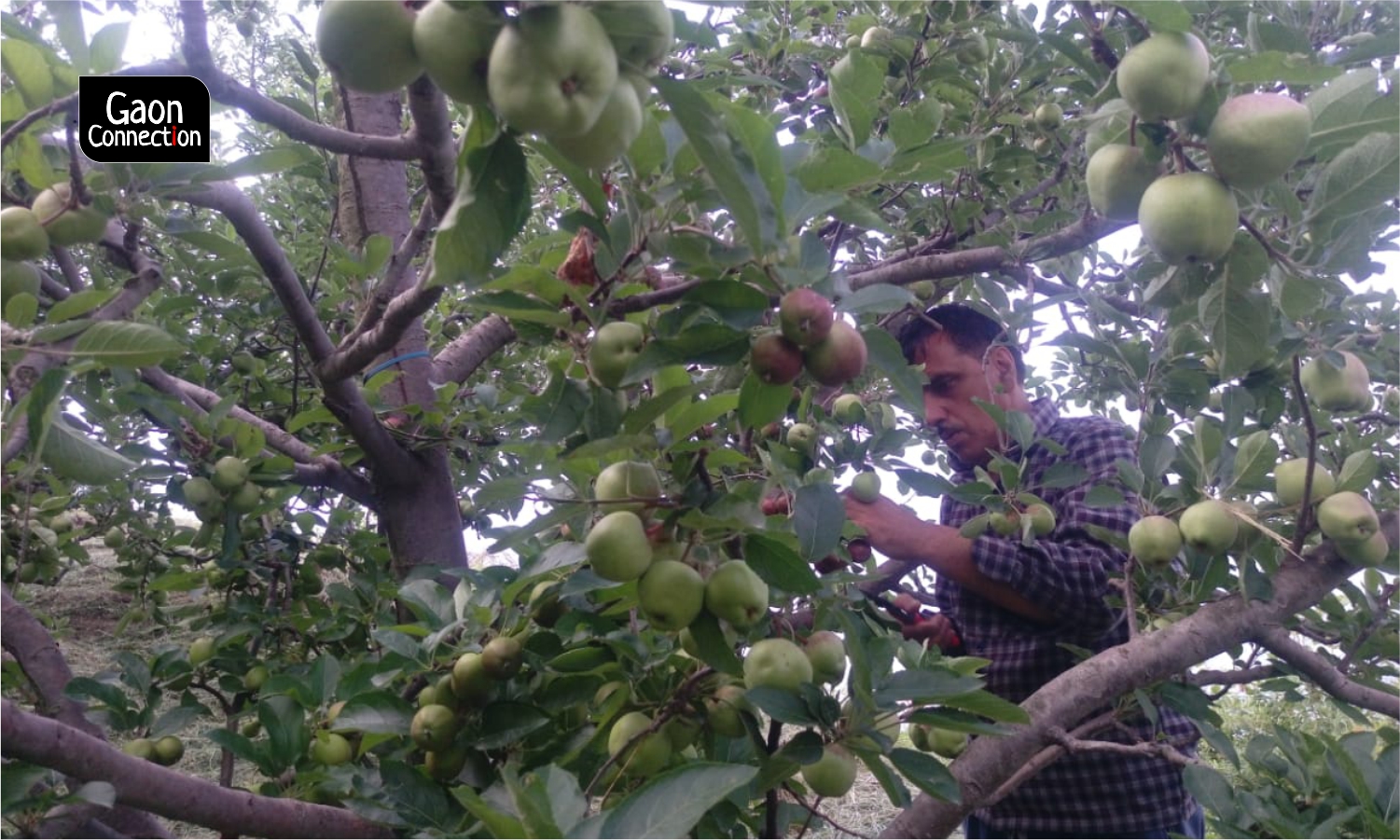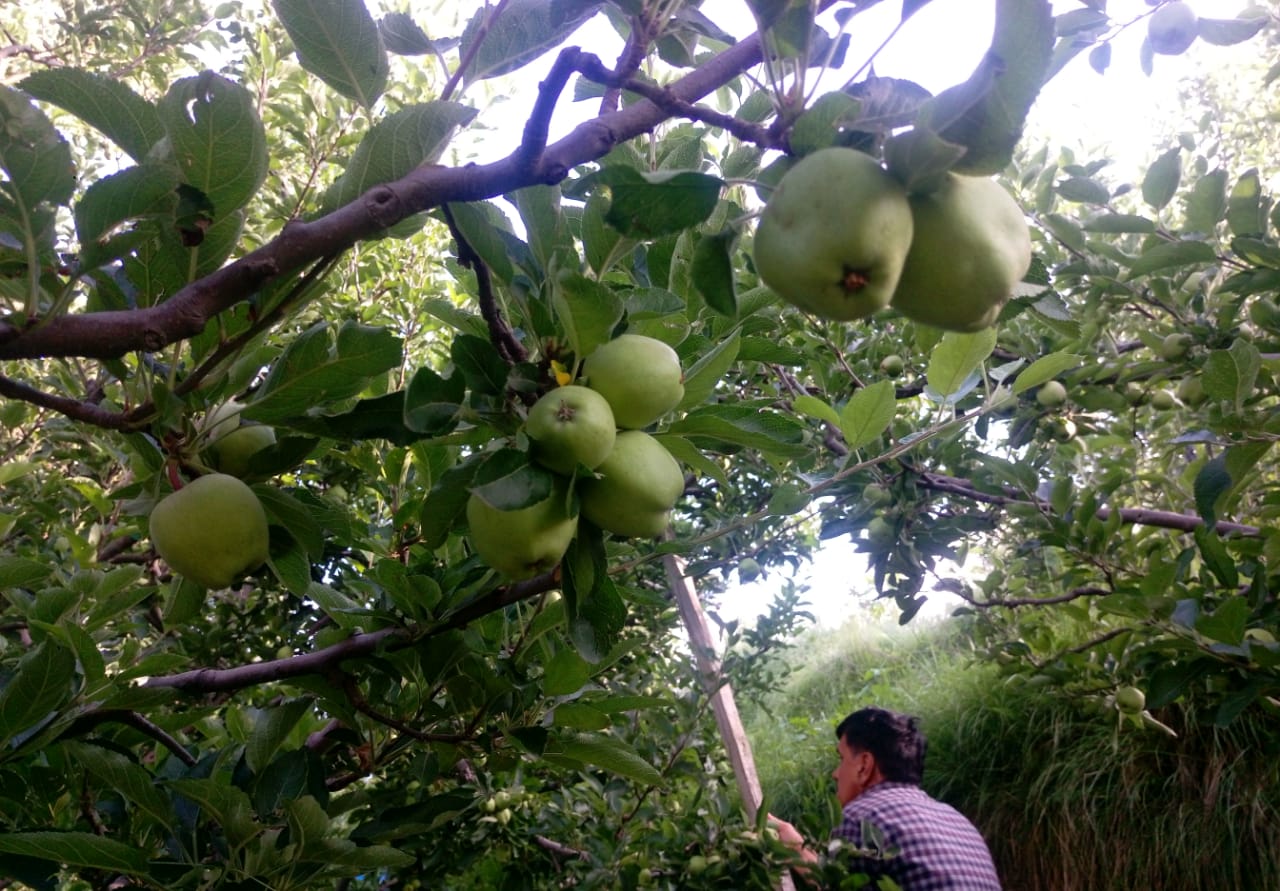After three decades, apple scab disease intensifies in Himachal’s orchards
As India is battling the COVID19 crisis, locust attacks in some states and floods in a few other, farmers of Himachal are staring at the possibility of apple scab disease turning into an epidemic.


Apple scab disease caused by fungus was first noticed in Himachal in 1977. Photo: Saurabh Chauhan
Shimla
Daya Ram, an apple farmer from Himachal Pradesh’s Mandi district, did not notice the velvety, olive-green lesions, with indefinite margins, on the tree leaves. He did take note of the lesions when it turned black, with margins becoming more definite, but did not suspect his orchard to be under a far-reaching fungal attack till it spread widely.
“We spotted some black spot on apples in the first week of July. We didn’t pay much heed but, it spread to 30 per cent of the orchard in a fortnight,” Daya told Gaon Connection. “I realised such spots were present on leaves and fruits last year also, but I had overlooked,” he added.

The WhatsApp groups of apple farmers are flooded with photos of tree leaves and fruits with similar spots. “Some farmers mistook it for some other disease and they have been doing so, in the last two-three years. This time, the problem is severe,” Balraj Sharma, an apple farmer from Kullu told Gaon Connection.
Some social media users came to Daya’s rescue. “Before reaching out to a fruit pathologist, we asked people on social media about these lesions. A few people confirmed it is ‘scab’,” he said. “I had heard about it but, saw it for the first time,” Daya confessed.
Apple scab disease, caused by fungus scientifically known as Venturia inaequalis, was first noticed in Himachal in 1977. The disease that can impair the size, shape, and colour of apples, had turned into an epidemic in 1982-83, infecting entire orchards.

Massive, nationwide campaigns were launched then, to help apple farmers tackle the fungal disease but, with time, farmers became careless. With a new lot of farmers not having witnessed the scab disease at an epidemic proportion, they were not able to identify it in their orchards.
There were reports of apple scab disease threatening the Rs 4,000-4,500 crore apple economy in June 2019, but the disease was reported only in some pockets of Himachal, unlike this year.
Dr Pankaj Gupta, Associate Director of Regional Horticultural Research and Training Station, Mashobara, said: “We surveyed the orchards in Shimla district and scab has caused damage to 50 per cent of some of the orchards in Baghi, Ratnari, Kharapathar, parts of Jubbal areas.”
“Scab in these areas has been noticed in past two years and we had been regularly advising farmers to follow the prescribed practices,” he added. If not managed properly this time around, it could turn worse next year.
Old, fallen leaves harbour apple scab lesions for the next year. That makes it important to collect and destroy all the leaves and bud woods from orchards. “When in school, we were taken to burn the leaves in apple orchards under a government program to destroy the apple scab fungus and combat the epidemic,” said DR Chauhan, a farmer from Shimla district.

“Post-harvest orchard management will play a crucial role next year,” said Pranav Rawat, an apple grower of Shimla district. This tedious process will also add to the input cost, adding to the woes of already-struggling farmers. The farm sector in Himachal is also hit by labour shortage.
“One black spot of scab in a fruit or a leaf has the capacity to spread the fungus to lakhs of fruits, leaves, and buds,” said a scientist at the Yashwant Singh Parmar University of Horticulture and Forestry. The University has issued an advisory to the farmers on effective management of apple scab fungal attack.
Apple harvesting in lower altitude areas has begun. Some farmers were able to contain the problem but, many orchardists in higher altitudes are worried since they could not tackle it in time. The scab attack is quite strong in higher altitudes due to excess moisture in the air. Some orchards in the lower and middle altitudes – 4,000-5,500 ft above sea level – have also been affected by scab.
Winters and early spring remain moist. This helps the fungus to sustain and spread. “Unfortunately, weather is favourable for the fungus and some farmers have still not been able to identify or notice it in their orchards,” said Yash Pal Dogra, an apple farmer from Shimla district.
“The scab has caught us, as well as the horticulture department, unaware,” said Kunaal Chauhan, a Shimla-based progressive apple farmer.
Dr Parvinder Kaushal, Vice-chancellor, Yashwant Singh Parmar University of Horticulture and Forestry, in its advisory said the excess moisture in the air due to wet spring and the arrival of monsoon resulted in the outbreak of the fungal disease.
“The problem of scab in apples, which was considered almost defunct, appeared in some areas of Himachal Pradesh last year. This year, incidents of scab fungal disease have been reported from Kullu, Mandi, and Shimla. Therefore, it is necessary to take measures to prevent the progression of the disease,” the advisory said.
The advisory also says the farmers should spray Propineb at 0.3 per cent concentration (600 gm/200 litres of water) or Dodine at 0.075 per cent concentration (150 gm/200 litres of water) or Metiram 55 per cent + Pyraclostrobin 5 per cent, WG (Vangard) at 0.15 per cent concentration (300gm/ 200 litres of water) among others for the management of apple scab.

Areas where its intensity is high, farmers have been spraying the chemicals every 10 to 12 days. This adds to the input cost too. “A farmer sprays 15 to 20 drums of fungicides on average, and a drum costs 300 rupees approximately. This shoots up our cost, ” said a farmer Gaon Connection spoke to.

Farmer bodies in the state want government intervention in terms of monetary and technical assistance to the farmers. “The government should ensure the fungicides are available on subsidised prices to the farmers besides loss assessment and compensation,” said Sanjay Chauhan, a Kisan Sabha leader.
“Regular awareness camps and effective fungicides at subsidised prices should be given to the farmers. There is a need to launch a campaign as the government did in 1980s,” said Harish Chauhan, fruit, vegetable, and flower association president.

